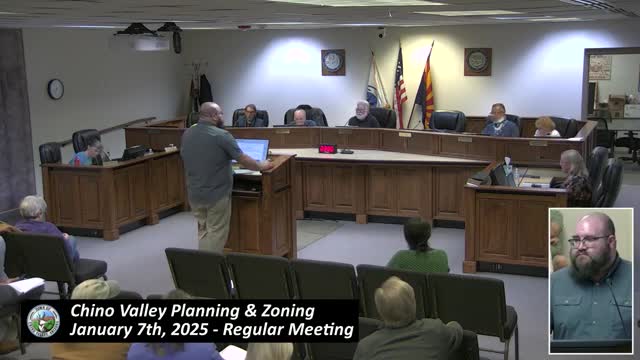Chino Valley Council debates solar project setback requirements and residential property impacts
February 01, 2025 | Chino Valley, Yavapai County, Arizona
This article was created by AI summarizing key points discussed. AI makes mistakes, so for full details and context, please refer to the video of the full meeting. Please report any errors so we can fix them. Report an error »

The Chino Valley Planning and Zoning Commission convened on January 7, 2025, to discuss several key issues regarding local development regulations, particularly focusing on solar energy projects and their impact on residential areas. The meeting highlighted the importance of ensuring that any new developments, especially those involving solar panels and battery storage systems, adhere to strict setback requirements to protect existing residential properties.
The commission began by addressing the necessity for developers to provide a bond or surety to ensure that they can cover cleanup costs in case of project abandonment or bankruptcy. This measure aims to safeguard the town's interests and maintain the integrity of the community.
A significant portion of the discussion revolved around the proposed ordinance concerning solar energy projects, which includes a maximum development area of 3,800 acres. The commission clarified that any future amendments to this acreage would follow the same procedural process as the current ordinance.
Commission members expressed concerns about the proposed separation distances for solar installations from residential properties. Initially, a quarter-mile setback was suggested; however, many members advocated for increasing this distance to one mile to minimize potential hazards, particularly in the event of battery fires. The commission debated the implications of such a distance, considering the limited land available for development in the area.
The conversation also touched on the distinction between developed and undeveloped residential properties. Some commissioners argued for a unified approach that would apply the same setback requirements to all residential properties, regardless of their development status. This change aims to prevent future conflicts as land use evolves.
Ultimately, the commission reached a consensus to recommend a one-mile separation from developed residential properties for solar panel installations. However, they acknowledged the challenges this might pose for future developments, particularly concerning existing land use rights and the potential for legal disputes.
As the meeting concluded, the commission emphasized the need for careful consideration of these regulations to balance the interests of solar energy development with the rights of existing property owners. The recommendations will be forwarded to the town council for further deliberation, with the hope of establishing clear and effective guidelines for future projects.
The commission began by addressing the necessity for developers to provide a bond or surety to ensure that they can cover cleanup costs in case of project abandonment or bankruptcy. This measure aims to safeguard the town's interests and maintain the integrity of the community.
A significant portion of the discussion revolved around the proposed ordinance concerning solar energy projects, which includes a maximum development area of 3,800 acres. The commission clarified that any future amendments to this acreage would follow the same procedural process as the current ordinance.
Commission members expressed concerns about the proposed separation distances for solar installations from residential properties. Initially, a quarter-mile setback was suggested; however, many members advocated for increasing this distance to one mile to minimize potential hazards, particularly in the event of battery fires. The commission debated the implications of such a distance, considering the limited land available for development in the area.
The conversation also touched on the distinction between developed and undeveloped residential properties. Some commissioners argued for a unified approach that would apply the same setback requirements to all residential properties, regardless of their development status. This change aims to prevent future conflicts as land use evolves.
Ultimately, the commission reached a consensus to recommend a one-mile separation from developed residential properties for solar panel installations. However, they acknowledged the challenges this might pose for future developments, particularly concerning existing land use rights and the potential for legal disputes.
As the meeting concluded, the commission emphasized the need for careful consideration of these regulations to balance the interests of solar energy development with the rights of existing property owners. The recommendations will be forwarded to the town council for further deliberation, with the hope of establishing clear and effective guidelines for future projects.
View full meeting
This article is based on a recent meeting—watch the full video and explore the complete transcript for deeper insights into the discussion.
View full meeting
